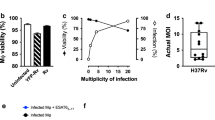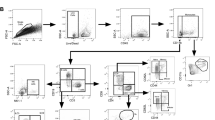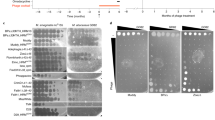Abstract
THE inactivation and clearing of infectious agents through adaptive immune responses results from interactions between T lymphocytes, B lymphocytes and mononuclear phagocytes1–4. The effector cells in cell-mediated immunity (CMI) are primarily T lymphocytes and mononuclear phagocytes1,5,6. CMI responses appear in two stages, lymphocyte activation with subsequent production of biologically active mediators, and recruitment and activation of other cells (particularly mono-nuclear phagocytes) as a result of the activity of several of these mediators1,3. Collaboration between T lymphocytes and macro-phages in bacterial infections mediated by a lymphokine that causes inhibition of the growth of organisms within the macro-phage has been assayed1,5,8. This inhibition probably results from increased macrophage microbiocidal activity1,5. The subject of this report is a lymphokine that reduces the viability of bacteria. The mechanism of action of this lymphokine is impairment of the ability to divide of otherwise metabolically active bacteria.
This is a preview of subscription content, access via your institution
Access options
Subscribe to this journal
Receive 51 print issues and online access
$199.00 per year
only $3.90 per issue
Buy this article
- Purchase on Springer Link
- Instant access to full article PDF
Prices may be subject to local taxes which are calculated during checkout
Similar content being viewed by others
References
WHO Scientific Group on Cell Mediated Immunity and Resistance to Infection, WHO Monograph (September, 1972).
Allison, A. C., Proc. R. Soc. Med., 66, 1151–1154 (1973).
Bloom, B. R., Adv. Immun., 13, 101–208 (1971).
Hill, H. R., Gerrard, J. M., Hogan, N. A., and Quie, P. G., J. clin. Invest., 53, 996–1002 (1974).
Fowles, R. E., Fajardo, I. M., Leibowitch, J. L., and David, J. R., J. exp. Med., 138, 952–964 (1973).
Blanden, R. V., Transplant. Rev., 19, 56–88 (1974).
North, R. J., Cell. Immun., 7, 166–176 (1973).
Krahenbuhl, J. L., Rosenberg, L. T., and Remington, J. S., J. Immun., 111, 992–995 (1973).
Graham, R. K., thesis, Univ. Western Australia (1968).
Seravalli, E., and Taranta, A., Cell. Immun., 8, 40–54 (1973).
Kolb, W. P., and Granger, G. A., Cell. Immun., 1, 122–132 (1970).
Bartholomaeus, W. N., and Keast, D., Aust. J. exp. Biol. med. Sci., 50, 603–609 (1972).
Salvin, S. B., Nishio, J., and Shonnard, J. T., Infect. Immunity, 9, 631–635 (1974).
Cowan, S. T., J. Path., 48, 545–555 (1939).
Author information
Authors and Affiliations
Rights and permissions
About this article
Cite this article
FLOWER, R., TURNER, K. & ALPERS, M. Mechanism of an action of an antibacterial murine lymphokine. Nature 254, 459–460 (1975). https://doi.org/10.1038/254459a0
Received:
Revised:
Issue Date:
DOI: https://doi.org/10.1038/254459a0
Comments
By submitting a comment you agree to abide by our Terms and Community Guidelines. If you find something abusive or that does not comply with our terms or guidelines please flag it as inappropriate.



